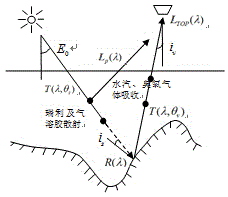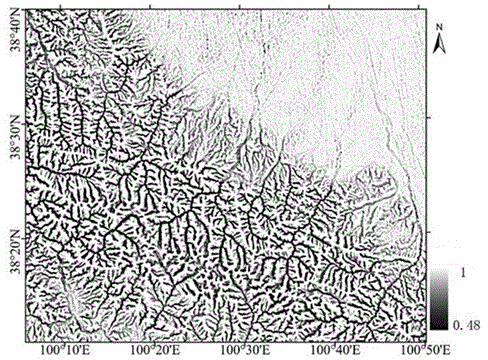Remote sensing image terrain standardization method
A remote sensing image and terrain technology, applied in the field of remote sensing, can solve the problems that cannot truly reflect the surface conditions
- Summary
- Abstract
- Description
- Claims
- Application Information
AI Technical Summary
Problems solved by technology
Method used
Image
Examples
Embodiment Construction
[0056] The present invention will be described in detail below in conjunction with the accompanying drawings and specific embodiments.
[0057] 1. Model method
[0058] 1. The principle of remote sensing image terrain standardization
[0059] like figure 1 As shown, the radiance of the top of the atmosphere (TOA) obtained by the satellite sensor L TOP ( lambda ) consists of two parts: path radiation L p ( lambda ) and radiation reflected from the surface L ( lambda ),which is:
[0060] L TOP ( lambda )= L p ( lambda )+ L ( lambda ) T ( lambda , θ ν ) (1)
[0061] In the formula: T ( lambda , θ ν ) represents the atmospheric transmittance in the observation direction of the sensor, and is the observation zenith angle of the sensor θ ν and a function of wavelength λ. Path radiation is mainly determined by Rayleigh scattering and aerosol scattering, and the specific calculation can refer to literature (Li et al., 2002). ...
PUM
 Login to View More
Login to View More Abstract
Description
Claims
Application Information
 Login to View More
Login to View More - R&D
- Intellectual Property
- Life Sciences
- Materials
- Tech Scout
- Unparalleled Data Quality
- Higher Quality Content
- 60% Fewer Hallucinations
Browse by: Latest US Patents, China's latest patents, Technical Efficacy Thesaurus, Application Domain, Technology Topic, Popular Technical Reports.
© 2025 PatSnap. All rights reserved.Legal|Privacy policy|Modern Slavery Act Transparency Statement|Sitemap|About US| Contact US: help@patsnap.com



